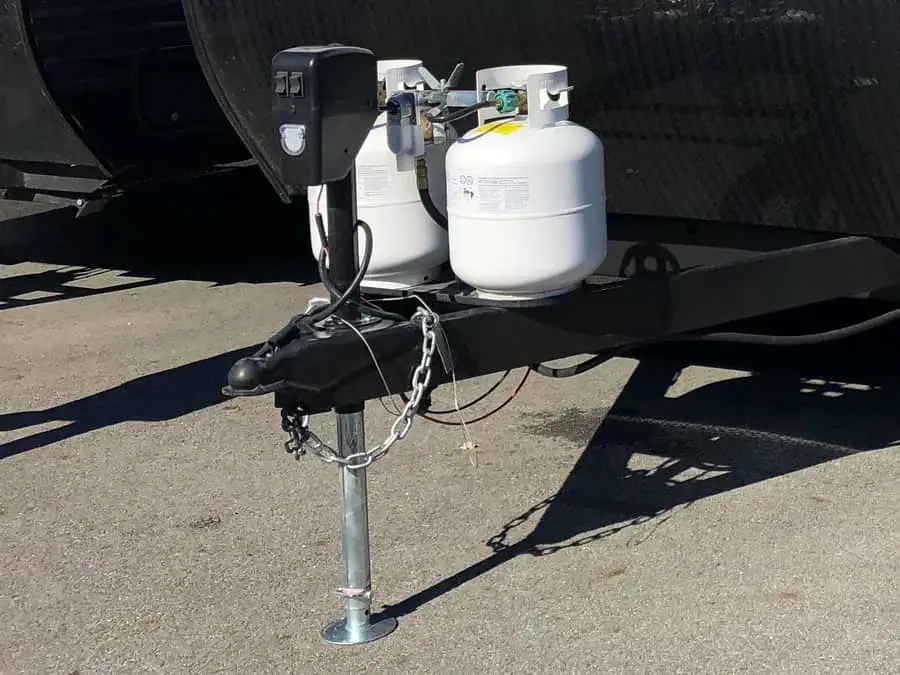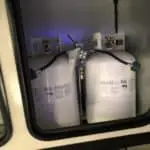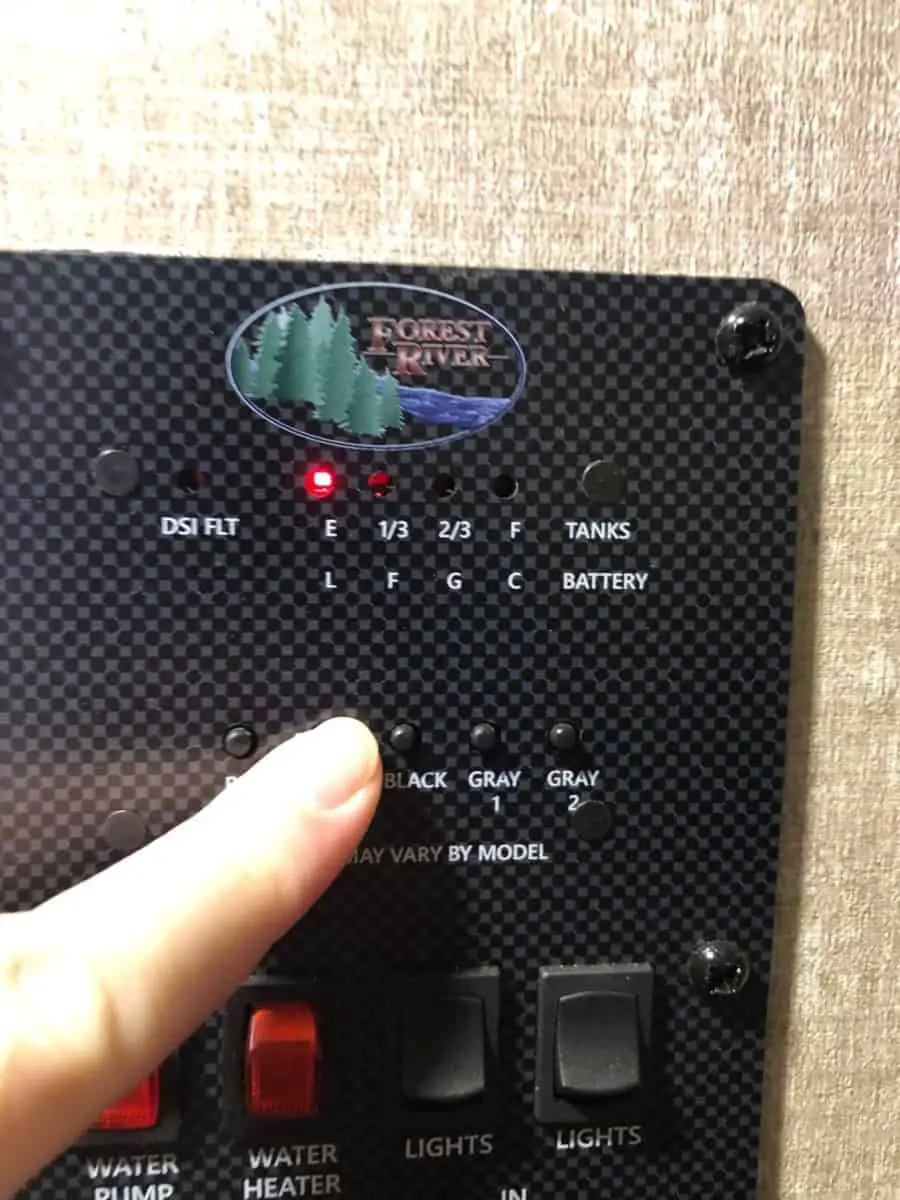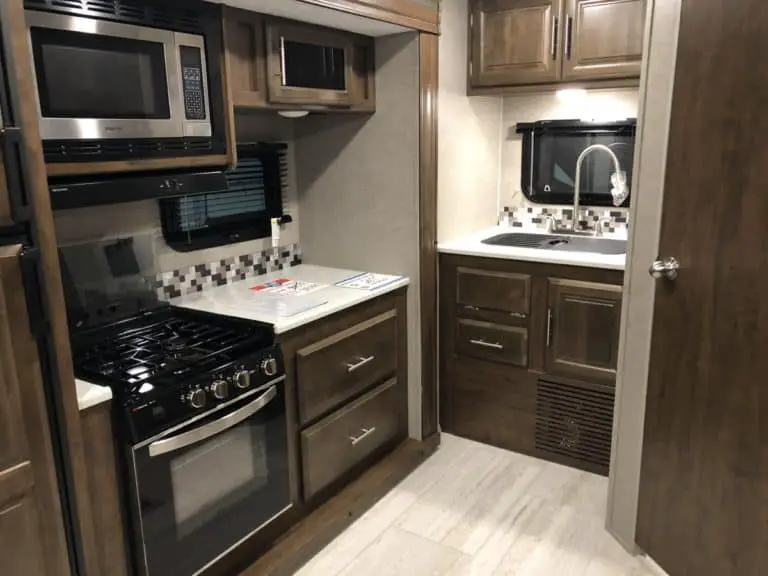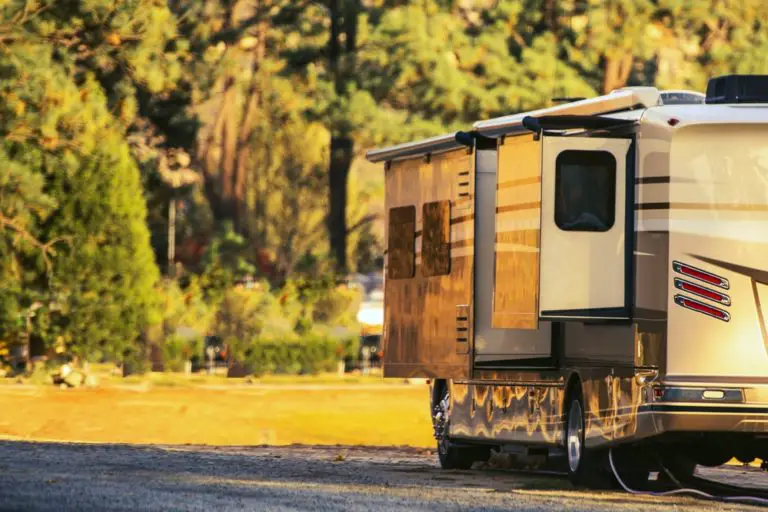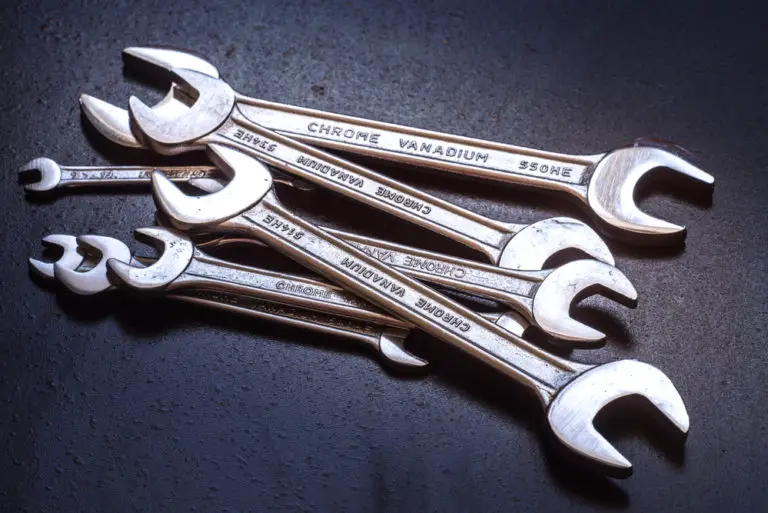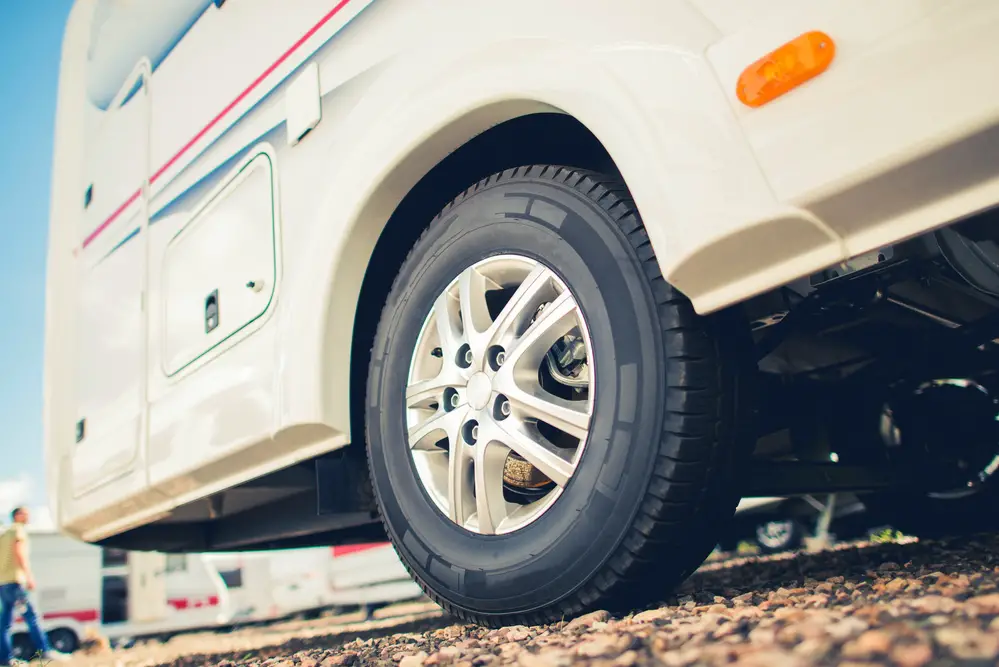4 Ways How To Tell How Much Propane Is Left in Your RV: A Guide for RV Owners
Trying to predict how much propane is left in your RV is like playing Russian Roulette. You might be lucky and have just enough for the night, or you could end up stranded without heat. To ensure that your experience is comfortable and safe, it’s essential to know how much propane is left in your RV.
You can tell how much propane is left in your RV using a propane electronic monitoring system, analog propane gauges, weighing your tank, or by the hot water trick. Electronic propane monitoring systems can learn your specific tank and provide the most accurate reading.
Typically, propane tanks in your trailer should last you at least a week, but this timing might change based on your use. This blog post will cover the best ways to determine the amount of propane left in your RV so you can have peace of mind and enjoy your road trip.
1. Make Use of an Electronic Propane Monitoring System
This is our favorite and most accurate way to measure propane tank levels. If you’re looking for a more advanced way to monitor the propane in your RV, consider getting an electronic monitoring system. These systems will give you the exact readings of your tank’s propane level.
The sensors are usually installed with a magnet on the bottom of your propane tank. You can then connect your phone via Bluetooth, allowing you to check the propane level in your tank with an app. This technology offers peace of mind for RVers who want to ensure they never run out of propane on their adventures.
I prefer using this model as it is the most accurate out of many we have tested. The Mopeka Pro dual tank monitor from Amazon.com. It’s an excellent monitoring system that’s easy to use and has a long-lasting battery making it perfect for RVers. It can also help you save time and energy, eliminating the need to check the amount of propane left in your tank manually.
2. Get a Propane Gauge
Investing in a propane pressure gauge is a more reliable and accurate way to measure the propane level in your RV. A propane gauge will give you an somewhat accurate reading of how much propane is in your tank. There are several different types of gauges on the market, so research what type is best for you.
The digital gauge we recommend below will give you the best readings, but this is a more cost effective way to determine your propane levels.
3. Use the Hot Water Trick
If you’re seeking a convenient way to measure the level of propane left in your RV, look no further than this age-old trick; all that is required is a container and some hot water. This method has been aiding campers for years in confidently determining their propane levels.
Hot water causes the propane in the tank to absorb the heat of the water. This will cause the metal side of the tank to be cool where the level of propane is lying. The other section above the propane level will feel warmer. This gives you a good indication of where your propane level is in the tank.
Here is how to use the hot water trick.
- Pour hot water onto the side of your tank.
- Place your hand on the surface and note which areas are hotter and which are colder.
- The colder area indicates the level of propane in the tank.
- The warmer area indicates the empty portion of the tank.
If you’re looking for an approximate reading of your propane level, this approach is perfect for any outdoor excursion. Although it’s less precise than a gauge, the method will still estimate how much propane remains in your tank.
4. Weigh the Propane Tank
Some people with experience can tell how much propane is left in their tank by picking it up. They judge the amount of propane by the tank’s weight.
However, this isn’t a foolproof method and doesn’t always work. Propane tanks come in different sizes and weights, making it difficult to determine the amount of gas in them.
For more accuracy, you can use a scale to weigh your tank preferably when empty. Next, use a permanent market to write the empty weight of your propane tank on the outside of the tank.
Now when you want to determine your propane level, weigh the tank and subtract the empty tank weight.
For example, if the weight of the tank is 27 lbs (12 kg) and the empty tank weight is 15 lbs, you know you have 10 lbs of propane left in your tank. If you have a 20 pound tank, then you have about 50% left.
Keep in mind that if you have a 20 pound tank, it will never be filled with 20 pounds of propane, they typically will only be filled about 80% full, so some more math to do. In our example if you have 10 pounds left, then you will have over 50% left.
Types of Propane Tanks and Their Sizes
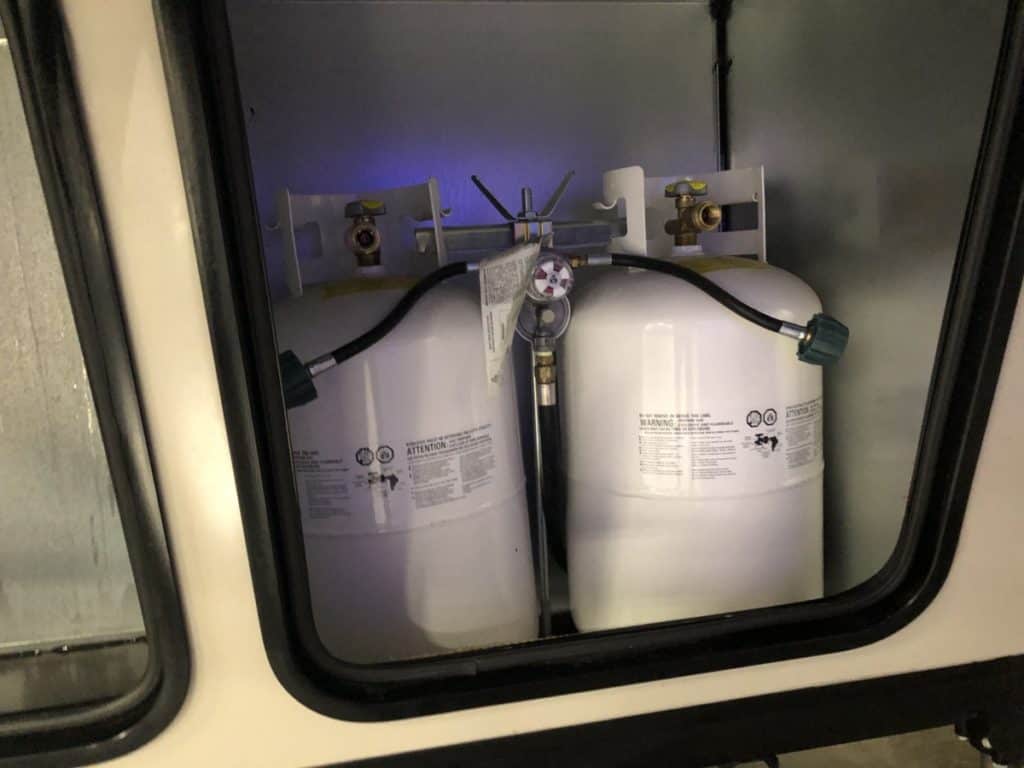
There are two primary types of propane tanks for your RV: ASME tanks and DOT cylinders. Each type has its own set of regulations and guidelines governing their use, which are enforced by organizations like the American Society of Mechanical Engineers (ASME) and the Department of Transportation (DOT). In this section, you’ll learn about the main types of propane tanks and their sizes.
ASME tanks are built to the specifications of the American Society of Mechanical Engineers. These tanks are typically permanently mounted to an RV, providing a larger and more consistent source of propane. ASME tanks come in a variety of sizes to suit different needs and the available space in your RV. Common sizes for RVs include 20, 30, and 40 gallons, with larger tanks available for custom installations.
On the other hand, DOT cylinders are designed to be portable, removable, and refillable. These propane tanks are subject to regulations from the Department of Transportation and are commonly used on smaller RVs and other recreational vehicles. DOT cylinders are available in sizes ranging from 5 to 100 pounds. Examples of common sizes include the 20-pound cylinder, which holds approximately 4.7 gallons of propane, and the 30-pound cylinder, which holds around 7 gallons.
When choosing a propane tank for your RV, consider factors such as your usage habits, the available space on your vehicle, and your preferences for the ease of refilling. If you often travel for extended periods or require larger amounts of propane, an ASME tank may be a more appropriate choice. For shorter trips or if you prefer the convenience of swapping out your propane tanks, DOT cylinders provide a more flexible option.
Remember that propane tanks have specific usage and maintenance requirements to ensure safety and longevity. Always follow manufacturer guidelines and industry best practices, and consult with a professional if you are unsure about any aspect of your propane system.
Safety Precautions and Maintenance Tips for RV Propane Systems
When dealing with propane in your RV, safety should always be your top priority. Here are some precautions and maintenance tips to help ensure a safe experience:
- Be vigilant for propane leaks: A gas leak can lead to an explosion if not detected and addressed promptly. If you smell propane or hear a hissing sound, it may be a sign of a leak. Be sure to shut off the main propane valve and call a professional for assistance.
- Keep your propane system clean and well-maintained: Propane is a clean-burning fuel, but it’s essential to keep your RV’s propane system clean and functioning properly. Regularly inspect and maintain your propane devices, such as stoves and heaters, to ensure they are operating efficiently.
- Invest in a carbon monoxide detector: Carbon monoxide can be produced by any fuel-burning appliance, including those running on propane. Installing a carbon monoxide detector in your RV will alert you if there’s a buildup of this dangerous gas.
- Use gadgets and devices to monitor propane levels: A propane level indicator or counter can be helpful in keeping track of how much propane you have left. These gadgets are typically easy to install and can be found at most RV supply stores.
- Check hoses and connections: Regularly inspect hoses and connections for wear and tear. Replace them if they appear damaged or brittle. This will help prevent leakages and improve your RV’s overall propane system performance.
- Be mindful of weather and temperature fluctuations: Propane pressure is affected by the ambient temperature. Keep your propane tank protected from extreme heat and cold, as this may cause fluctuations in the gas pressure, leading to potential issues with your propane appliances.
By following these safety precautions and maintenance tips, you can ensure that your RV’s propane system remains in top condition, allowing you to enjoy the many benefits and conveniences it brings to your travels.
RV Propane System FAQ’s
How can I tell how much propane is left in my RV tank? To determine the level of propane in your RV tank, you can use a propane gas gauge or a digital propane scale. Another method is the hot water test: pour hot water over the side of the tank, then run your hand down the side of the tank to feel where it goes from hot to cold. The cold area indicates the propane level.
My refrigerator won’t stay cold on propane. What can be the issue? If your refrigerator isn’t staying cold while running on propane, there are a few possible solutions. Firstly, check the propane level and ensure there’s enough gas. Secondly, verify the connection and condition of the propane regulator. Lastly, check the burner assembly and gas jet for dirt or obstructions, and clean them if necessary.
Why is my propane not flowing properly? Propane flow issues could be due to the following reasons:
- An empty or low fuel tank.
- A faulty or obstructed propane regulator.
- Air in the propane lines, which can be resolved by slowly opening the tank valve and allowing the air to purge.
- A kink or obstruction in the hoses.
How can I make sure my propane system is safe and functioning properly? Regular maintenance and checks are essential. Be sure to:
- Inspect your propane tanks and hoses for damage or wear.
- Test all propane appliances and connections for leaks using a soapy water solution.
- Have a professional service technician inspect your propane system annually.
- Install a propane gas detector in your RV to alert you of leaks.
What is the recommended refrigerator temperature setting while running on propane? Generally, the recommended temperature for an RV refrigerator is between 34℉ (1°C) and 40℉ (4°C). To achieve this while running on propane, set your refrigerator’s thermostat to the GAS setting and start at the mid-level setting. Adjust as needed to accommodate weather conditions and load size.
Be the first to be notified about FREE tips, hints, coupon codes, and email-exclusive information. All for FREE!

